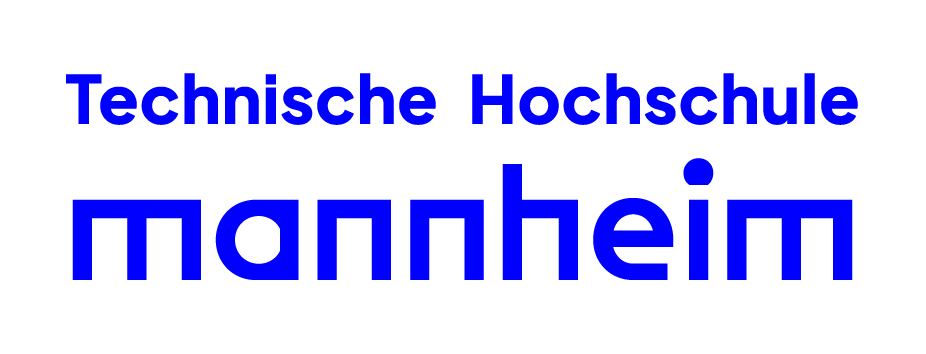CompletableFuture Framework
Parallele Programmierung (3IB)

Überblick
- Monte-Carlo-Berechnung von \(\pi\)
- sequentiell und parallel mit
Future
- sequentiell und parallel mit
CompletableFuture(Framework)- lineare Verarbeitungsketten und Verzweigen/Vereinen
- Synchronisations-Barrieren
- Fehlerbehandlung in asynchronen Ketten
- Monte-Carlo-Berechnung von \(\pi\)
- parallel mit
CompletableFuture
- parallel mit
=> Grundlage: Hettel und Tran (2016, Kap. 15)
Monte-Carlo-Berechnung von \(\pi\)
Monte-Carlo-Berechnung von \(\pi\)
- zufällig gewählte Punkte mit Koordinaten ([0..1], [0..1])
- man kann leicht feststellen, ob Sie genau auf, innerhalb oder außerhalb des Einheitsviertelkreis (\(r=1\)) liegen

Monte-Carlo-Berechnung von \(\pi\)
- sehr viele Punkte (
x,y) mit gleichmäßiger Verteilung - das Verhältnis der Anzahl der Punkte innerhalb des Viertelkreises zu allen innerhalb des Quadrats entspricht dem Verhältnis der Fläche des Viertelkreises (Radius 1) zur Fläche des Quadrats (Kantenlänge 1)
\[\frac{\mbox{Anzahl der Punkte innerhalb und auf dem Kreis}}{\mbox{Anzahl aller Punkte}} = \frac{\frac{\pi r^2}{4}}{r^2}\]
- da \(r=1\), kann \(\pi\) angenähert werden als:
pi = 4.0 * in / (in + out)in: Anzahl der Punkte innerhalb des Kreises (sqrt(x*x + y*y) <= 1)out: die restlichen, die außerhalb des Kreises liegen (sqrt(x*x + y*y) > 1)
Laboraufgabe “Monte-Carlo-Algorithmus zur Annäherung von \(\pi\) – sequenziell”
- Projekt:
pp.08.01-ConcurrencyMonteCarloPiSeq - Bearbeitungszeit: 5 Minuten
- Musterlösung: 5 Minuten
- Kompatibilität: mindestens Java SE 16
Laboraufgabe “Monte-Carlo-Algorithmus zur Annäherung von \(\pi\) – mit Future”
- Projekt:
pp.08.02-ConcurrencyMonteCarloPiFuture - Bearbeitungszeit: 15 Minuten
- Musterlösung: 15 Minuten
- Kompatibilität: mindestens Java SE 16
Überblick und Grundlagen von CompletableFuture
Laboraufgabe commonPool
- Projekt:
pp.08.03-CommonPool - Bearbeitungszeit: 10 Minuten
- Musterlösung: 10 Minuten
- Kompatibilität: mindestens Java SE 10
Zweck von CompletableFuture
- Pipelining: funktionale Verkettung mehrerer
Future/Callable- Output eines
Callablewird Input für nächstesCallable - verwendet Regeln, um zu entscheiden, wo nächstes
Callableausgeführt wird:- im vorigen Thread
- im Aufrufer-Thread oder
- einem neuen Thread
- Output eines
- Verwendung des
commonPool - asynchrone Methodenaufrufe
- Standard für verteilte Architekturen
- reaktive Programmierung / reaktive Architektur \(\to\) “hängt” nicht, (vertikal) skalierbar
Grundlegende Struktur von CompletableFuture
Future: read-only Container für zukünftiges Ergebnis (“Promise”)CompletionStage: triggert weitere Verarbeitung
CompletionStage (Push-API)
- bietet eine Reihe von Dreier-Paaren:
- “nicht-asynchrone”
Ausführung - asynchrone Ausführung in
commonPool - asynchrone Ausführung
mit eigenemExecutor
stattcommonPool
- “nicht-asynchrone”
- Ergebnis ist immer eine neue
CompletionStage
CompletionStage (Push-API)
Überblick über das API von CompletableFuture

nach Hettel und Tran (2016, 240) (Änderungen: Annotationen und supplyAsync statt applyAsync in Start-API)
internes API
static CompletableFuture<Integer> calculateAsync() {
var result = new CompletableFuture<Integer>();
ForkJoinPool.commonPool().submit(() -> {
try {
var res = /* aufwändige Berechnung, Ergebnis z.B. */ 42;
result.complete(res);
} catch (Exception ex) {
result.completeExceptionally(ex);
}
});
return result;
}
public static void main(String... args) {
var cf = calculateAsync();
try {
System.out.println(cf.get());
} catch (InterruptedException e) {
Thread.currentThread().interrupt();
} catch (ExecutionException e) {
System.err.print(e);
}
}Start-API
import java.util.concurrent.CompletableFuture;
import java.util.concurrent.ExecutionException;
import java.util.function.Supplier;
public class SimpleCompletableFuture {
static class Task implements Supplier<Integer> {
@Override
public Integer get() {
return /* aufwändige Berechnung, Ergebnis z.B. */ 42;
}
}
public static void main(String... args)
throws InterruptedException, ExecutionException {
var future = CompletableFuture.supplyAsync(new Task());
System.out.println(future.get());
}
}Start-API
import java.util.concurrent.CompletableFuture;
import java.util.concurrent.ExecutionException;
public class SimpleCompletableFuture {
public static void main(String... args)
throws InterruptedException, ExecutionException {
var future = CompletableFuture.supplyAsync(() -> {
return /* aufwändige Berechnung, Ergebnis z.B. */ 42;
});
System.out.println(future.get());
}
}Push-API von CompletableFuture
– lineare Ketten und Verzweigungen –
asynchrone Verarbeitungskette
Für jedes thenApplyAsync und theAcceptAsync wird ggf. ein eigener Thread aus dem Threadpool benutzt.
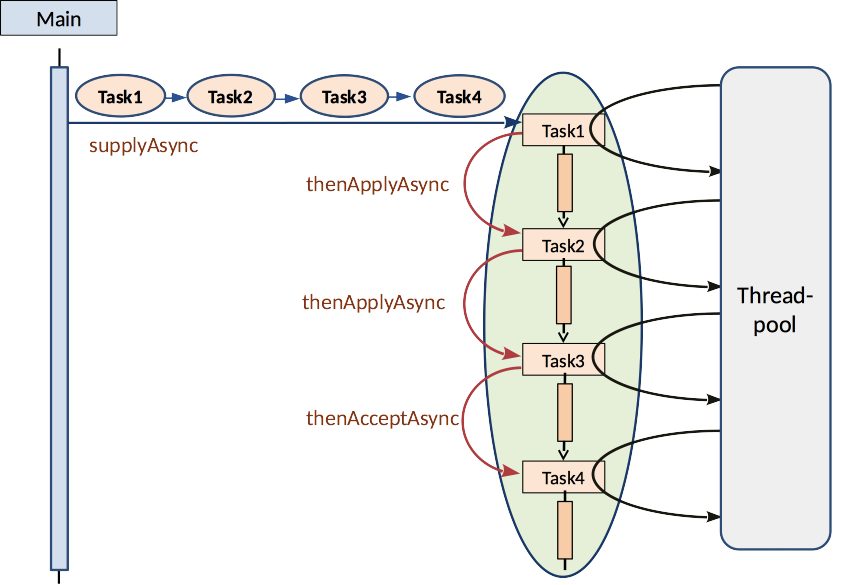
asynchrone Verarbeitungskette

Hettel und Tran (2016, 252) (modifiziert)
Beispiel für eine asynchrone Verarbeitungskette
public class Service {
static User getUser(int userId) { ... }
static Profile getProfile(User user) { ... }
static AccessRight getAccessRight(Profile profile) { ... }
}
CompletableFuture<Void> cf = CompletableFuture
.supplyAsync(() -> Service.getUser(42))
.thenApplyAsync((user) -> Service.getProfile(user))
.thenApplyAsync((profile) -> Service.getAccessRight(profile))
.thenAcceptAsync((access) -> System.out.println(access));
cf.join(); // wartet auf das Ende der Berechnung von cf,
// hier also auf die erfolgte AusgabeBeispiel für eine asynchrone Verarbeitungskette
public class Service {
public static User getUser(int userId) { ... }
public static Profile getProfile(User user) { ... }
public static AccessRight getAccessRight(Profile profile) { ... }
}
CompletableFuture<Void> cf = CompletableFuture
.supplyAsync(() -> T)
.thenApplyAsync((T t) -> U)
.thenApplyAsync((U u) -> V)
.thenAcceptAsync((V v) -> Void); // void (kleingeschrieben)
// ist in Java kein Typ, sondern ein Schlüsselwort in Signaturen
cf.join();“nicht-asynchrone” Verarbeitungsschritte
| Methode | Task-Typ | Resultat | ||
|---|---|---|---|---|
thenRun |
Runnable: () -> void |
CompletableFuture<Void> |
||
thenAccept |
Consumer: (T) -> void |
CompletableFuture<Void> |
||
thenApply |
Function: (T) -> U |
CompletableFuture<U> |
- Falls der “vorige”
CompletableFuture-Task schon fertig ist, wird der nächste Task im Aufrufer-Thread ausgeführt. - Falls der “vorige”
CompletableFuture-Task noch nicht fertig ist, wird der nächste Task anschließend im Thread des vorigen Tasks ausgeführt.
Split-Pattern
T:String'4711'
U:Integer4
V:Booleanfalse
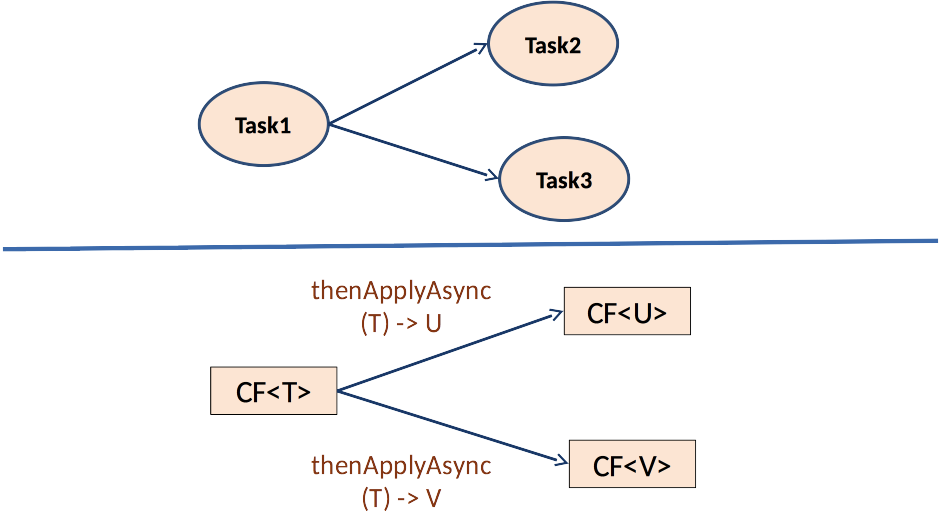
Hettel und Tran (2016, 252)
Vereinen von Verarbeitungsketten

Hettel und Tran (2016, 252)
Methoden zur Vereinigung von Abläufen. “CF” steht für CompletableFuture und “CS” für CompletionStage
Zusammenführen durch thenCombine (Verrechnen)
T:Integer47
U:String'11'
V:String'4711'
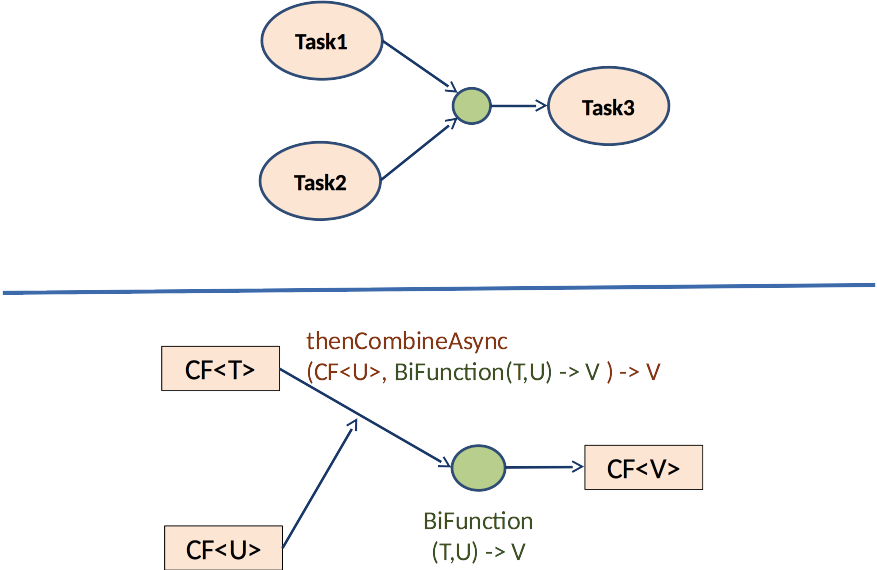
Hettel und Tran (2016, 253)
Zusammenführen durch applyToEither (“ODER”)
T:Integer47
U:Integer11
V:Booleantrueoderfalse
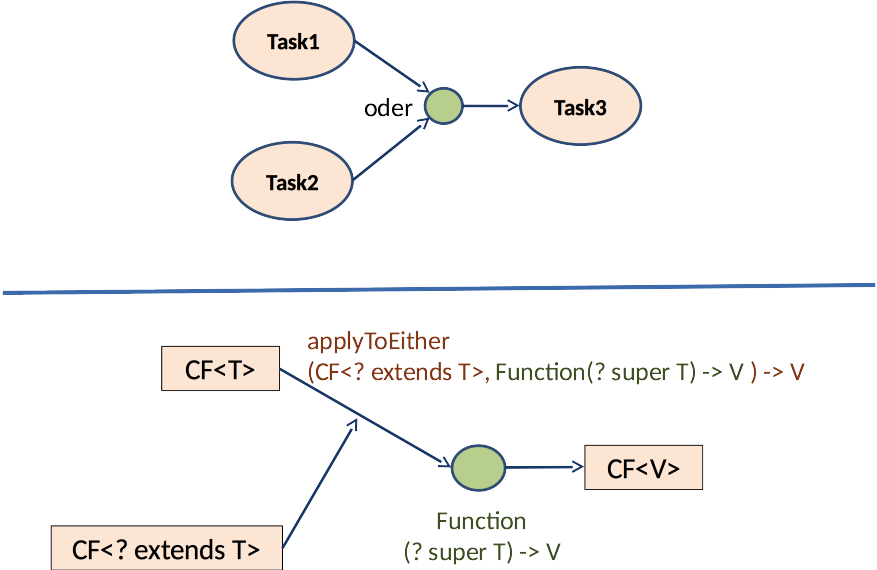
Hettel und Tran (2016, 255)
Barrieren und Zusammenführen
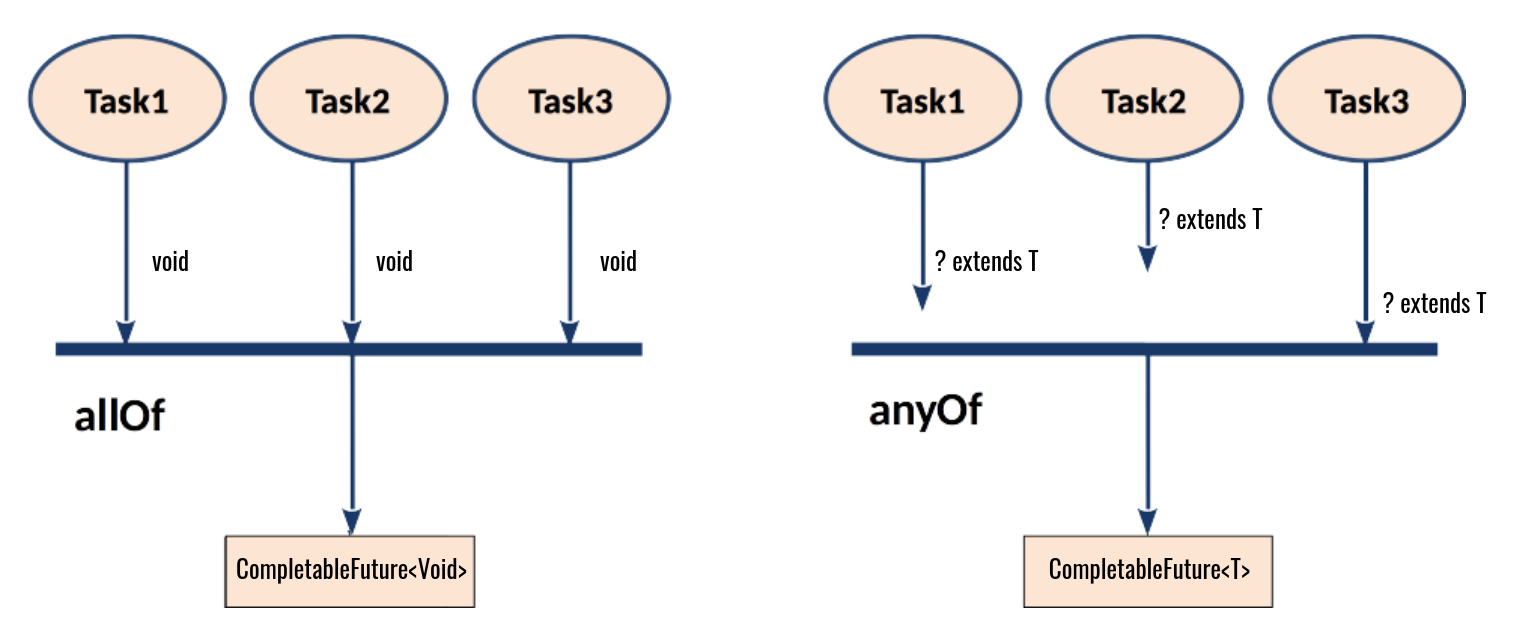
Hettel und Tran (2016, 257) (modifiziert)
Barrieren und Zusammenführen
CompletableFuture.allOf( // alle müssen beendet werden
CompletableFuture.runAsync( () -> { /*...*/ } ),
CompletableFuture.runAsync( () -> { /*...*/ } ),
CompletableFuture.runAsync( () -> { /*...*/ } )
).thenAccept((Void) -> System.out.println("done") );
CompletableFuture.anyOf( // das frühest fertige
CompletableFuture.supplyAsync( () -> { /*...*/ } ),
CompletableFuture.supplyAsync( () -> { /*...*/ } ),
CompletableFuture.supplyAsync( () -> { /*...*/ } )
).thenAccept((first) -> System.out.println(first));Fehlerbehandlung und Abbruch
var cf = CompletableFuture
.supplyAsync(() -> 42)
.thenApplyAsync(r -> r / 0)
.thenApplyAsync(r -> r * r)
.thenApplyAsync(r -> r > 0)
.handle((r, th) -> {
if (r != null) {
System.out.println("Resultat: " + r);
return r;
} else {
System.err.println("error: " + th);
return false;
}
});
System.out.println(cf.join());
Hettel und Tran (2016, 258) (modifiziert)
Fehlerbehandlung und Abbruch
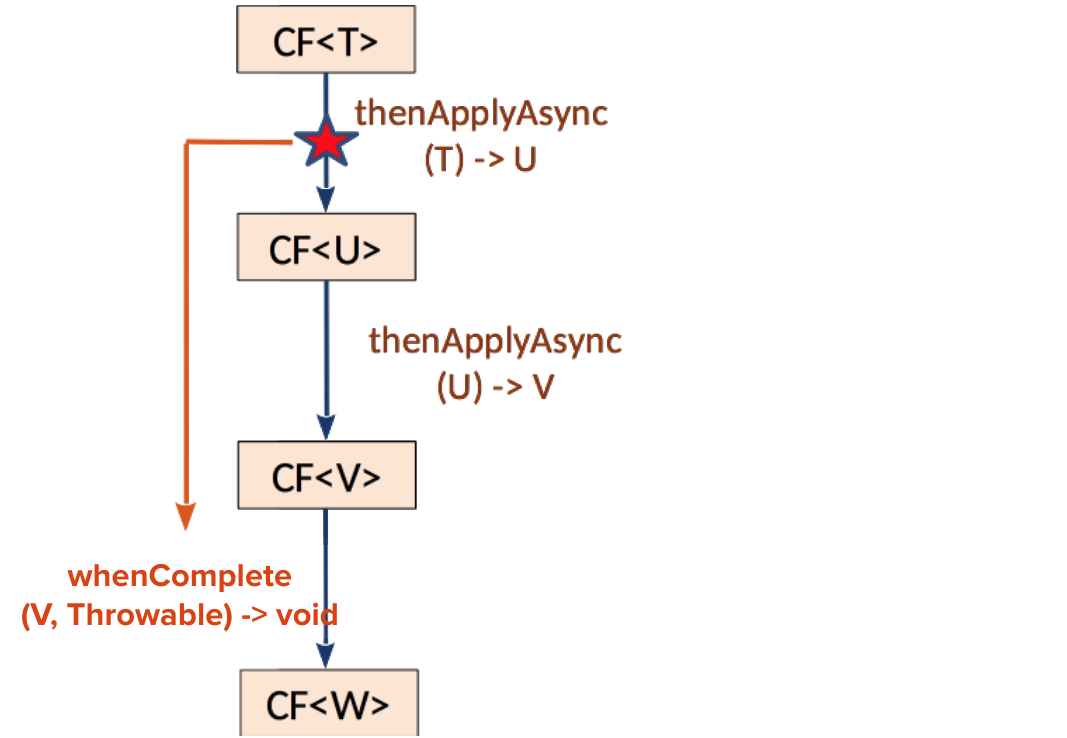
Hettel und Tran (2016, 258) (modifiziert)
Monte-Carlo-Berechnung von \(\pi\)
Laboraufgabe “Monte-Carlo-Algorithmus zur Annäherung von \(\pi\) – mit CompletableFuture”
- Projekt:
pp.08.04-ConcurrencyMonteCarloPiCF - Bearbeitungszeit: 15 Minuten
- Musterlösung: 15 Minuten
- Kompatibilität: mindestens Java SE 16
Referenzen
